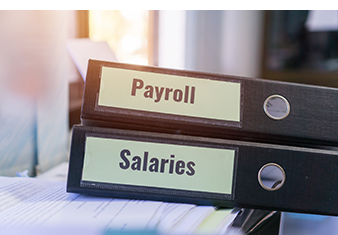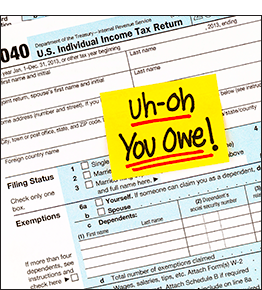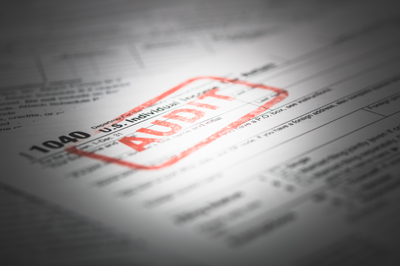If you or your business received funds from the Paycheck Protection Program (PPP), the recently passed Emergency Coronavirus Relief Act of 2020 will help to dramatically cut your tax bill. Here’s what you need to know.
Background
 The PPP program was created by the CARES Act in March 2020 to help businesses which were adversely affected by the COVID-19 pandemic. Qualified businesses could apply for and receive loans of up to $10 million. Loan proceeds could be used to pay for certain expenses incurred by a business, including salaries and wages, other employee benefits, rent and utilities.
The PPP program was created by the CARES Act in March 2020 to help businesses which were adversely affected by the COVID-19 pandemic. Qualified businesses could apply for and receive loans of up to $10 million. Loan proceeds could be used to pay for certain expenses incurred by a business, including salaries and wages, other employee benefits, rent and utilities.
If the business used at least 60% of loan proceeds towards payroll expenses, the entire amount of the loan would be forgiven.
The Dilemma
While the CARES Act spelled out that a business’s forgiven PPP loan would not be considered taxable income, the legislation was silent about how to treat expenses paid for using PPP loan proceeds if the loan was ultimately forgiven.
Congress intended for these expenses to be deductible for federal tax purposes. But since the legislation was silent on this issue, the IRS swooped in and deemed these expenses to be nondeductible.
There was considerable debate over the latter half of 2020, with Congressional politicians explaining that their intent was that the expenses be deductible and the IRS responding “Too bad, they’re nondeductible.”
The Solution
Congress overruled the IRS’s position in the Emergency Coronavirus Relief Act of 2020. The legislation officially makes deductible for federal tax purposes all expenses paid for using proceeds from a forgiven PPP loan.
Stay tuned for updates as to how this new legislation affects your business.
 No one likes surprises from the IRS, but they do occasionally happen. Here are some examples of unpleasant tax situations you could find yourself in and what to do about them.
No one likes surprises from the IRS, but they do occasionally happen. Here are some examples of unpleasant tax situations you could find yourself in and what to do about them.
- An expected refund turns into a tax payment. Nothing may be more deflating than expecting to get a nice tax refund and instead being met with the reality that you actually owe the IRS more money.
What you can do: Run an estimated tax return and see if you may be in for a surprise. If so, adjust how much federal income tax is withheld from your paycheck for the balance of the year. Consult with your company’s human resources department to figure out how to make the necessary adjustments for the future. If you’re self-employed, examine if you need to increase your estimated tax payments due in January, April, June and September.
- Getting a letter from the IRS. Official tax forms such as W-2s and 1099s are mailed to both you and the IRS. If the figures on your income tax return do not match those in the hands of the IRS, you will get a letter from the IRS saying that you’re being audited. These audits are now done by mail and are commonly known as correspondence audits. The IRS assumes their figures are correct and will demand payment for the taxes you owe on the amount of income you omitted on your tax return.
What you can do: Assuming you already know you received all your 1099s and W-2s and confirmed their accuracy, verify the information in the IRS letter with your records. Believe it or not, the IRS sometimes makes mistakes! It is always best to ask for help in how to correspond and make your payments in a timely fashion, if they are justified.
- Getting a tax bill for an emergency retirement distribution. Due to the pandemic, you can withdraw money from retirement accounts in 2020 without getting a 10% early withdrawal penalty, but you’ll still have to pay income taxes on the amount withdrawn. If you don’t plan for this extra tax you will be surprised with an additional tax bill. And you may still get an underpayment penalty bill from the IRS because you did not withhold enough during the year. You may also still receive an early withdrawal penalty in error because the IRS is still scrambling to update their systems with all of this year’s tax relief changes.
What you can do: Set aside a percentage of your distribution for taxes. Your account administrator may withhold funds automatically for you when you request the withdrawal, so check your statements. Your review should be for both federal and any state tax obligations. If the withholding is not sufficient, consider sending in an estimated tax payment. And if you are charged a withdrawal penalty, ask for help to correspond with the IRS to get this charge reversed.
No one likes surprises when filing their taxes. With a little planning now, you can reduce the chance of having a surprise hit your tax return later.
If you are working from home for the first time in 2020, you may be wondering if your home office is tax deductible. The bad news? If you’re working from home for an employer, you normally can’t deduct your home office expenses.
 Here’s a quick look at the basic requirements to be able to deduct your home office expenses, along with some suggestions for how to qualify for the deduction if you’re currently working for your company as an employee.
Here’s a quick look at the basic requirements to be able to deduct your home office expenses, along with some suggestions for how to qualify for the deduction if you’re currently working for your company as an employee.
The basics
There are two requirements for having a tax-deductible home office:
- Your home office is only used for business purposes. Your home office must be used exclusively for operating your business. It can’t double as the family media center or living room. To meet this requirement, set up your office in a separate area of your house. Then if you get audited by the IRS, there is no doubt that your office is used exclusively for business purposes.
- Your home office is your primary place of business. You need to demonstrate that your home office is the primary place you conduct your business. The IRS has clarified that you can meet clients and conduct meetings at separate office locations, but your home office must be the only location where your administrative work is completed. So, if you meet with clients or work on any part of your business away from your home office, keep a journal of each specific activity undertaken and describe how it doesn’t violate the primary place-of-business rule.
Looking at these two criteria, everyone that is now required to work from home probably meets both qualifications. If you’re a W-2 employee, however, you can’t deduct your home office expenses on your tax return.
Solving the problem
Here are three options for solving your problem of being a W-2 employee and qualifying to deduct your home office expenses on your tax return.
- Become an independent contractor. The easiest way to deduct your home office expenses is by switching from being an employee to an independent contractor. With a number of firms cutting pay and hours due to the pandemic, it may be worth exploring. There’s a big warning label if you go this route, however. You will need to account for lost benefits, such as health insurance, and the additional cost of self-employment taxes. If you can meet the IRS requirements for becoming an independent contractor, it may be worth doing the math and considering all the deductions your home office may make available to you.
- Start a side business. If becoming an independent contractor for your current employer isn’t an option, consider starting a side business. You can deduct all business-related expenses on your tax return, including your home office expenses. If you go this route, ensure your home office is in a different location in your home than your other work space.
- Consider your entire household. Even if you don’t qualify for the home office deduction, maybe someone else living in your home does qualify. So, look into your options to see if a family member can take advantage of the home office deduction.
What if none of these options for deducting home office expenses are feasible for you? While you won’t be able to deduct your home office expenses on your tax return, you may still be able to end up financially ahead with the help of your employer.
Get reimbursed by your company
There’s no question you are picking up some of the expense of your home office with added electrical, heating, telephone, internet, and other expenses. One way companies are solving this is by allowing employees to submit valid expense reports to cover some of these extra costs. They do this by setting up an accountable plan. With financial pressures on businesses, this might be a tough subject to broach, but if the system is already in place you may be able to find a way to get some of your home office expense reimbursed.
So if you’re stuck working as a W-2 employee, look into whether your employer offers reimbursement for home office expenses.
Figuring out how to properly deduct your home office or get reimbursed by your employer can be a lot more complicated than it appears. If you need help, contact your financial advisor.
 The IRS recently announced its 2020 edition of its annual Dirty Dozen list of tax scams with a special emphasis on aggressive and evolving schemes related to COVID-19 tax relief, including Economic Impact Payments. Here are six of the more common scams.
The IRS recently announced its 2020 edition of its annual Dirty Dozen list of tax scams with a special emphasis on aggressive and evolving schemes related to COVID-19 tax relief, including Economic Impact Payments. Here are six of the more common scams.
Phishing. Phishing refers to potential fake emails or websites looking to steal your personal information. Remember the IRS will never initiate contact with you via email about an outstanding tax bill, refund or Economic Impact Payment.
What you can do. If you receive any suspicious phishing emails, forward them to phishing@irs.gov.
Fake charities. Criminals frequently exploit natural disasters and other crisis situations such as this year’s pandemic by setting up fake charities to steal donations. Fraudulent schemes normally start with unsolicited contact by telephone, text, social media, e-mail or even in person.
What you can do. Verify the charity’s existence by searching for it using the IRS’s search tool.
Threatening phone calls from IRS impersonators. IRS impersonation scams include phone calls threatening arrest, deportation or license revocation if you don’t pay a bogus tax bill. The IRS will never demand immediate payment or ask for financial information over the phone.
What you can do. If you received a phone call, contact your local IRS office to verify whether you owe any taxes.
Social media scams. A scammer will use social media platforms such as Facebook and Twitter to obtain personal information from you, then use that information to trick you into providing them with confidential information. For example, the scammer could impersonate a family member, friend or co-worker in an attempt to obtain financial information.
What you can do. Be careful of publishing confidential information on social media. Verify the identity of any person or organization that asks you for confidential information.
Economic impact payment or tax refund theft. Criminals file false tax returns or supply other bogus information to the IRS to divert refunds or Economic Impact Payments to wrong addresses or bank accounts.
What you can do. Contact a qualified professional to help walk you through how to report identity theft to the IRS.
Senior fraud. Senior citizens have become more comfortable with various technologies such as social media. This has opened the door for scammers to take advantage of senior citizens by using fake emails, text messages and fake websites to steal personal information.
What you can do. Be the eyes and ears for the senior citizens you come in contact with. According to the IRS, anecdotal evidence indicates that senior fraud decreases substantially when a trusted friend or family member takes an interest in the senior’s affairs.
 In 2018, the government attempted to “simplify” the tax-filing process by drastically shortening Form 1040. The result was six new schedules that created a lot of confusion. Now the IRS is attempting to ease some of that pain by revising the form and removing some schedules. Will it help? Here is what you need to know:
In 2018, the government attempted to “simplify” the tax-filing process by drastically shortening Form 1040. The result was six new schedules that created a lot of confusion. Now the IRS is attempting to ease some of that pain by revising the form and removing some schedules. Will it help? Here is what you need to know:
- More information on the main form. To make it easier for the IRS to match pertinent information across related tax returns, new fields have been added on the main Form 1040. For example, there’s now a spot for your spouse’s name if you choose the married filing separate status. In addition, there’s a separate line for IRA distributions to more clearly differentiate retirement income.
- 3 schedules are gone. What was your favorite memory of Schedules 4, 5 and 6? Was it the unreported Social Security tax on Schedule 4? Or the credit for federal fuels on Schedule 5? While those schedules will no longer exist, those lines (and many others) have found a new home on one of the first three schedules. Less paperwork, but still the same amount of information.
- You can keep your pennies! For the first time, the IRS is eliminating the decimal spaces for all fields. While reporting round numbers has been common practice, it’s now required.
- Additional changes on the way. The current versions of Form 1040 and Schedules 1, 2 and 3 are in draft form and awaiting comments on the changes. Because of the importance of the 1040, the IRS is expecting to make at least a few updates in the coming weeks (or months) before they consider it final. Stay tuned for more developments.
How to prepare for the changes
The best way to prepare is to be aware that 1040 changes are coming. The information required to file your taxes will remain the same, but some additional hunting will be necessary to find the shifting lines and fields on the modified form.
Remember, changes bring uncertainty and potential for delays, so getting your tax documents organized as early as possible will be key for a timely tax-filing process.
The Consumer Financial Protection Bureau recently reported in financial exploitation cases that older adults lost an average of $34,200. Unfortunately, these funds are often never recovered. You can ensure this doesn’t happen by learning more about scams and how to protect yourself. Here are some tips:

- Recognize the scams.The best way to protect yourself from a scam is to understand what they look and sound like. Here are a few key elements to look for when identifying a scam:
- You are promised a great offer or benefits
- You are forced to make quick decisions
- You are pressured to provide financial and/or personal information
- You are threatened
Did you know? IRS impersonation scams are the No. 1 scam targeting older adults, according to the Treasury Inspector General for Tax Administration, with more than 2.4 million Americans targeted.
- Know why you are a target.You and other older adults may be targeted because you own a home, and have retirement savings and exceptional credit — a treasure trove for con artists to pillage. Scammers take advantage of trusting older adults because they’re less likely to say no and sometimes have cognitive issues that affect decision-making skills. In other cases, family members and non-related caregivers may have easier access to their funds, making them more susceptible to theft.
- Keep your personal and financial information safe. Keep your bank information, Social Security card and other finances stored somewhere secure in your home. Think twice about what you are sharing on Facebook, and don’t give out your Social Security or account numbers without vetting the person or company asking you for it. Con artists find useful information on social media sites about your family members and then pretend to be a relative who asks for money, or they could directly ask you for sensitive information over the phone or via email.
- Hang up if you feel uncomfortable. Don’t worry about being impolite if someone on the phone is pressuring you into sharing sensitive information. Hang up. If the call comes from a company you trust, you can call back and ask for the department that handles your account to determine if the call is for a legitimate reason.
- Turn down unsolicited offers. If you receive a call or an in-person visit from someone you don’t know selling you a product or service you didn’t request, turn it down or tell them you’ll decide at a later time. If the service or product interests you, conduct independent research on three suppliers. Proactively contact all three and determine the best offer. Include a trusted family member in the decision-making process. Doing this can effectively eliminate most scams.
- Use direct deposit. You can avoid having your checks stolen when you arrange for your checks to be directly deposited into your bank account. Ask your bank to show you how.
- Speak up if you think you’re a scam victim. There’s no need to feel embarrassed or ashamed if you think you’ve been scammed. Instead, let people know right away.
- Call your bank and/or credit card companies.
- Reset your account passwords.
- Call the police to report stolen property.
- Submit a consumer complaint using the FTC consumer Complaint Assistant.
- Report the scam by calling the United States Senate Special Committee on Aging Fraud Hotline at 1-855-303-9470.
- If you suspect elder abuse is also involved, contact adult protective services.
 Sleuthing your way through a tax audit by yourself is not the same as fixing a leaky faucet or changing your oil. Here are reasons you should seek professional help as soon as you receive a letter from the IRS:
Sleuthing your way through a tax audit by yourself is not the same as fixing a leaky faucet or changing your oil. Here are reasons you should seek professional help as soon as you receive a letter from the IRS:
- IRS auditors do this for a living — you don’t. Seasoned IRS agents have seen your situation many times and know the rules better than you. Even worse, they are under no obligation to teach you the rules. Just like a defendant needs the help of a lawyer in court, you need someone in your corner that knows your rights and understands the correct tax code to apply in correspondence with the IRS.
- Insufficient records will cost you. When selected for an audit, the IRS will typically make a written request for specific documents they want to see. The list may include receipts, bills, legal documents, loan agreements and other records. If you are missing something from the list, things get dicey. It may be possible to reconstruct some of your records, but you might have to rely on a good explanation to avoid additional taxes plus a possible 20 percent negligence penalty.
- Too much information can add audit risk. While most audits are limited in scope, the IRS agent has the authority to increase that scope based on what they find in their original analysis. That means that if they find a document or hear something you say that sounds suspicious, they can extend the audit to additional areas. Being prepared with the proper support and concise, smart answers to their questions is the best approach to limiting further audit risk.
- Missing an audit deadline can lead to trouble. When you receive the original audit request, it will include a response deadline (typically 30 days). If you miss the deadline, the IRS will change your tax return using their interpretation of findings, not yours. This typically means assessing new taxes, interest and penalties. If you wish your point of view to be heard — get help right away to prepare a plan and manage the IRS deadlines.
- Relying on an expert gives you peace of mind. Tax audits are never fun, but they don’t have to be pull-your-hair-out stressful. Together, you and your expert can map out a plan and take it step-by-step to ensure the best possible outcome. You’ll rest easy knowing your audit situation is being handled by someone with the proper expertise that also has your best interests in mind.
The IRS announced that eligible employers who provide paid family and medical leave to their employees may qualify for a new business credit for tax years 2018 and 2019. Notice 2018-71 provides detailed guidance on the new credit in a question and answer format. The credit was enacted in the 2017 Tax Cuts and Jobs Act.
The notice released clarifies how to calculate the credit including the application of special rules and limitations. Only paid family and medical leave provided to employees whose prior-year compensation was at or below a certain amount qualify for the credit. Generally, for tax year 2018, the employee’s 2017 compensation from the employer must have been $72,000 or less.
To claim the credit, an employer must have a written policy that satisfies the following requirements:
- The policy must cover all qualifying employees; that is, all employees who have been employed for a year or more and were paid not more than a specified amount during the preceding year, generally not more than $72,000 in 2017.
- The policy must provide at least two weeks of annual paid family and medical leave for each full-time qualifying employee and at least a proportionate amount of leave for each part-time qualifying employee.
- The policy must provide for payment of at least 50% of the qualifying employee’s wages while the employee is on leave.
- If an employer employs qualifying employees who are not covered by Title I of the FMLA, the employer’s written policy must include language providing “non-interference” protections, as described in Section A of Notice 2018-71. Thus, the written policy must incorporate the substantive rules that must be met for an employer to be eligible for the credit.
Any leave paid by a state or local government or required by state or local law is not taken into account for any purpose in determining the amount of paid family and medical leave provided by the employer, meaning those amounts do not qualify for the credit.
For purposes of the credit, an employer is any person for whom an individual performs services as an employee under the usual common law rules applicable in determining the employer-employee relationship. Wages qualifying for the credit are determined under the Federal Unemployment Tax Act (FUTA) rules but disregarding the $7,000 FUTA wage limit.
The notice is effective Sept. 24, 2018, and applies to tax years beginning after Dec. 31, 2017, until Dec. 31, 2019. The contents of the notice will be incorporated into proposed regulations, which the IRS is requesting comments on through Nov. 23.
Source: Journal Of Accountancy
 Getting audited by the IRS is no fun. Some taxpayers are selected for random audits every year, but the chances of that happening to you are very small. You are much more likely to fall under the IRS’s gaze if you make one of several common mistakes.
Getting audited by the IRS is no fun. Some taxpayers are selected for random audits every year, but the chances of that happening to you are very small. You are much more likely to fall under the IRS’s gaze if you make one of several common mistakes.
That means your best chance of avoiding an audit is by doing things right before you file your return this year. Here are some suggestions:
Don’t leave anything out. Missing or incomplete information on your return will trigger an audit letter automatically, since the IRS gets copies of the same tax forms (such as W-2s and 1099s) that you do.
Double-check your numbers. Bad math will get you audited. People often make calculation errors when they do their returns, especially if they do them without assistance. In 2016, the IRS sent out more than 1.6 million examination letters correcting math errors. The most frequent errors occurred in people’s calculation of their amount of tax due, as well as the number of exemptions and deductions they claimed.
Don’t stand out. The IRS takes a closer look at business expenses, charitable donations and high-value itemized deductions. IRS computers reference statistical data on which amounts of these items are typical for various professions and income levels. If what you are claiming is significantly different from what is typical, it may be flagged for review.
Have your documentation in order. Be meticulous about your recordkeeping. Items that will support the tax breaks you take include: cancelled checks, receipts, credit card and investment statements, logs for mileage and business meals and proof of charitable donations. With proper documentation, a correspondence letter from the IRS inquiring about a particular deduction can be quickly resolved before it turns into a full-blown audit.
Remember, the average person has a less than 1 percent chance of being audited. If you prepare now, you can narrow your audit chances even further and rest easy after you’ve filed.
 Is a worker an independent contractor or an employee? This seemingly simple question is often the contentious subject of IRS audits. As an employer, getting this wrong could cost you plenty in the way of Social Security, Medicare, and other employment-related taxes. Here is what you need to know.
Is a worker an independent contractor or an employee? This seemingly simple question is often the contentious subject of IRS audits. As an employer, getting this wrong could cost you plenty in the way of Social Security, Medicare, and other employment-related taxes. Here is what you need to know.
The basics
As the worker. If you are a contractor and not considered an employee, you must:
- Pay self-employment taxes (Social Security and Medicare-related taxes)
- Make estimated federal and state tax payments
- Handle your own benefits, insurance and bookkeeping
As the employer. You must ensure your employee versus independent contractor determination is correct. Getting this wrong in the eyes of the IRS can lead to:
- Payment and penalties related to Social Security and Medicare taxes
- Payment of possible overtime including penalties for a contractor reclassified as an employee
- Legal obligation to pay for benefits
Things to consider
When the IRS re-characterizes an independent contractor as an employee, they look at the business relationship between the employer and the worker. The IRS focuses on the degree of control exercised by the employer over the work done and they assess the worker’s independence. Here are some guidelines:
- The more the employer has the right to control the work (when, how and where the work is done), the more likely the worker is an employee
- The more the financial relationship is controlled by the employer, the more likely the relationship will be seen as an employee and not an independent contractor To clarify this, an independent contractor should have a contract, have multiple customers, invoice the company for work done, and handle financial matters in a professional manner
- The more businesslike the arrangement, the more likely you have an independent contractor relationship
While there are no hard-set rules, the more reasonable your basis for classification and the more consistently it is applied, the more likely an independent contractor classification will not be challenged.